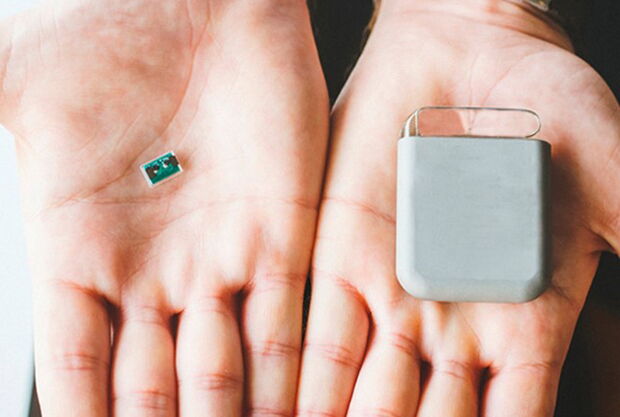Implantable Technology Breakthrough
SCHOTT Primoceler’s bonding process used in a collaboration with Geissler Companies and IRD Glass - Development of safer, non-magnetic implant Implantable devices can be safely encapsulated in miniature all-glass packages using SCHOTT Primoceler’s room-temperature bonding process that allows the use of heat-sensitive materials. This opens the possibility for non-magnetic materials to be used in implantable electronics, which have previously relied on heat-resistant ferrous metals as part of their construction.
Tampere, Finland: Of the marvels in modern medicine, implantable medical devices rank near the top as one of the most beneficial, life-changing technologies introduced in recent decades. However, the heat-intensive manufacturing processes used to create these devices in a way that enables reliability and long-term performance has resulted in the near-exclusive use of heat-resistant ferrous (magnetic) metals in their construction. While these robust metals help deliver sound reliability and performance for implants, they come with a number of potential drawbacks that may include interference with magnetic resonance imaging (MRI) and even a potential for effects on performance from exposure to magnetic fields. SCHOTT Primoceler has developed a new bonding process to allow for implantables to be hermetically sealed at room temperature using their signature laser-based Glass Micro Bonding process, opening the possibility for companies to use non-ferrous metals in these devices.
Magnetic Materials: The current standard with inherent drawbacks
Typically, implants with electronic components are constructed with ferrous metals incorporated inside them. Common examples where these materials are used include pacemakers, RFID tags, neurostimulators, and various other implants with wireless communication functions. The robust and rigid nature of ferrous metals leaves them nearly unaffected by extreme elements. However, their magnetic properties mean exposure to other magnetic fields must be minimized. Patients are the ones who feel the effects of this: those with implants containing ferrous metals must undergo MRI procedures under precautions that include close monitoring of the device.
Hermetic Sealing Without Heat
Glass Micro Bonding removes heat from the process for hermetically sealing sensitive electronics, a key benefit in the manufacturing of implantable devices. Using a laser to create a vacuum-tight bond between two or more glass interfaces, the sealing procedure is extremely precise and carries a heat-affected zone of just a few microns – effectively establishing the method as a room-temperature process.
A Promising Development for Implants of the Future
Successful implementation of this non-magnetic implantable device could open the door for a host of other new implant designs. Those with pacemakers, especially older models, know the limitations of medical imaging and even potential harm from devices such as metal detectors they face due to the construction of their device. These circumstances could become a thing of the past with new designs using non-ferrous materials.
Ville Hevonkorpi, Managing Director of SCHOTT Primoceler Oy, expressed optimism for future developments in implantable devices following the success of this collaboration: “Our core philosophy at SCHOTT Primoceler is to find ways we can use Glass Micro Bonding to enable improvement of existing products in the market or even open entirely new application possibilities. Innovation is at the heart of everything we do. We are particularly excited about the prospect of implantable devices that cooperate with miniaturization requirements and critical medical imaging processes thanks to an outstanding collaborative effort with IRD Glass and Geissler.”
Jochen Herzberg, Medical Program Manager of SCHOTT’s Electronic Packaging business unit, adds: “We are a ready and willing partner to take on the complex component design and quality challenges faced by top innovators in the medical industry. This exceptional collaboration from the teams at SCHOTT Primoceler, Geissler, and IRD Glass on this project adds to the established custom-designed components and capabilities SCHOTT offers for implantable and medical devices, including customized glass-to-metal sealed hermetic packages and feedthroughs as well as sterilizable connectors and LEDs for surgical devices.”
Representatives from SCHOTT will be present and available to discuss custom-designed packaging and technology for components used in implants and medical devices at industry events in California, USA during the month of February. SCHOTT can be found at Photonics West booth #841 in San Francisco from February 4-6, and MDM West booth #3080 in Anaheim from February 11-13.
SCHOTT is a leading international technology group in the areas of specialty glass, glass-ceramics and related high-tech materials. With over 130 years of experience, the company is an innovative partner to many industries, including the home appliance, pharma, electronics, optics, life sciences, automotive and aviation industries. SCHOTT has a global presence with production sites and sales offices in 34 countries. In the 2018/2019 fiscal year, the group generated sales of EUR 2.2 billion with over 16,200 employees. SCHOTT AG has its headquarters in Mainz (Germany) and is solely owned by the Carl Zeiss Foundation. This is one of the oldest private and largest science-promoting foundations in Germany. As a foundation company, SCHOTT assumes special responsibility for its employees, society and the environment.

Source: SCHOTT North America, Inc.
